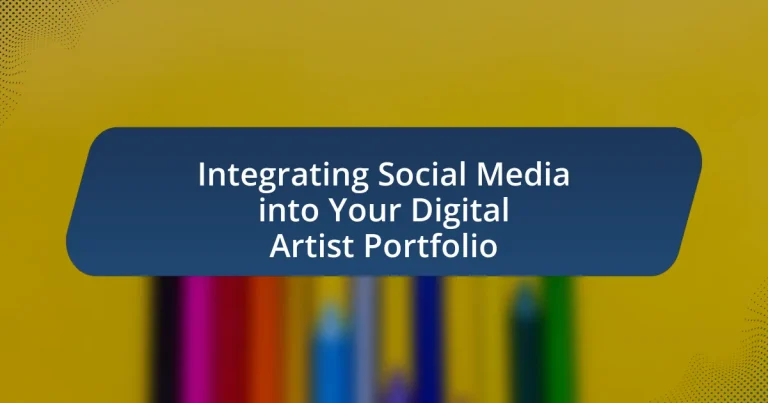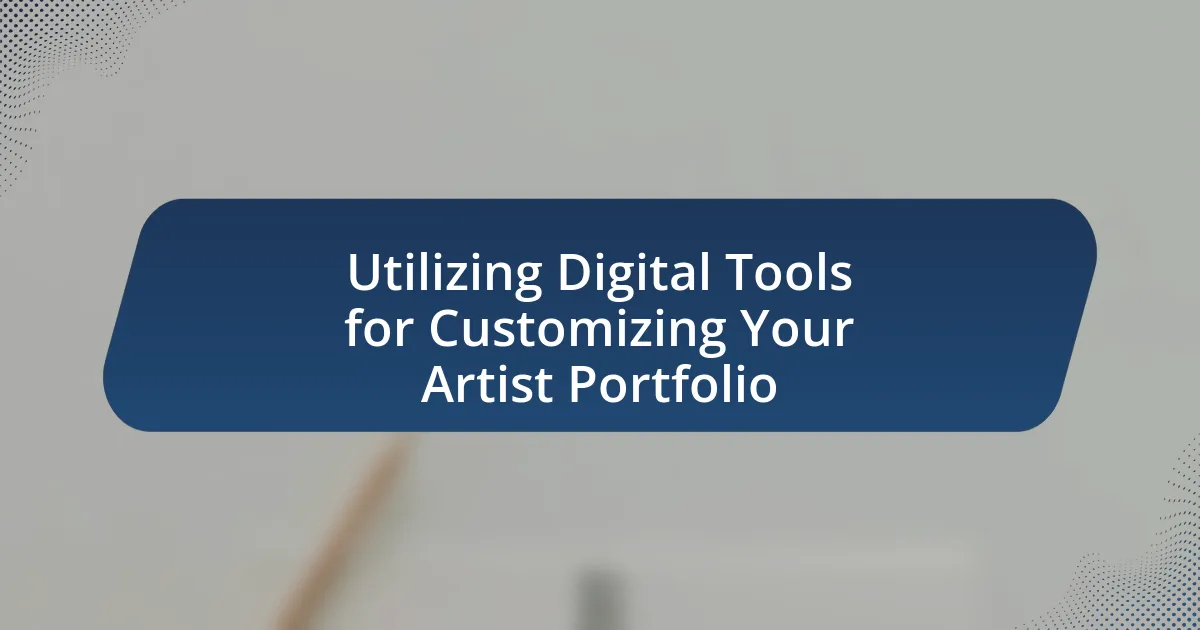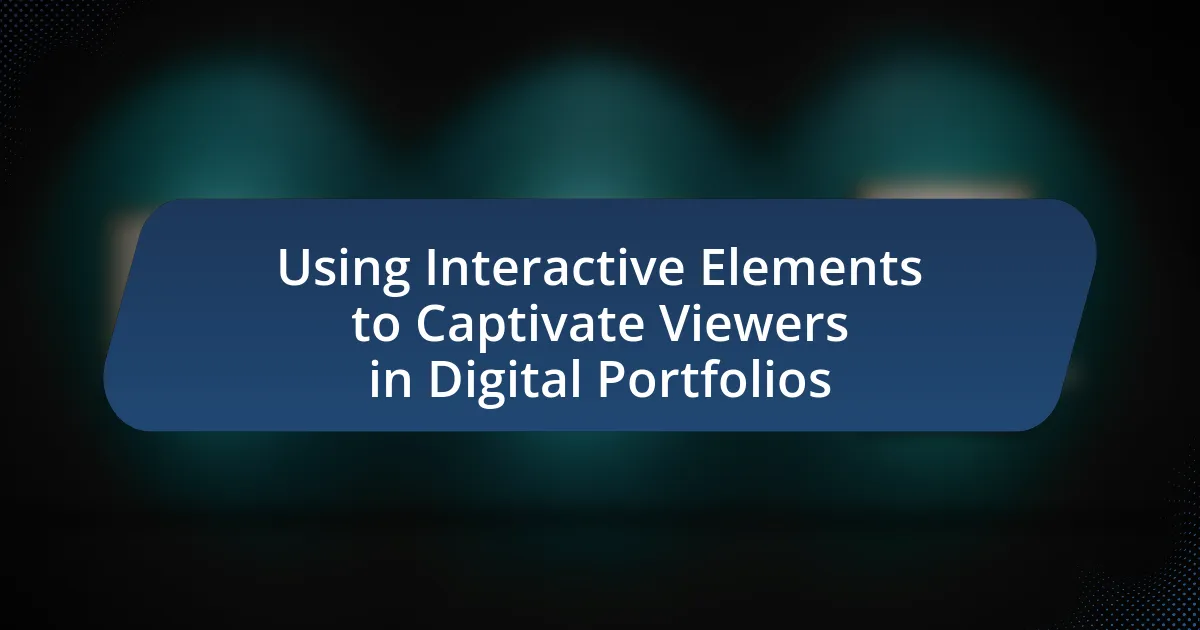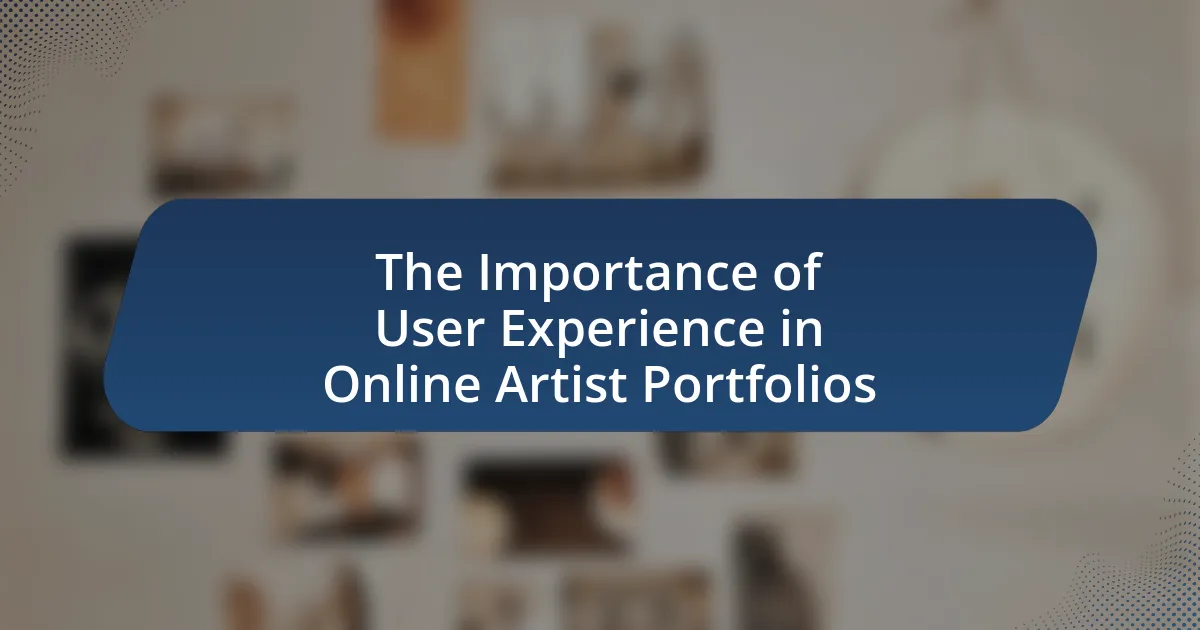Integrating social media into a digital artist portfolio involves using platforms like Instagram, Behance, and ArtStation to showcase artwork, engage with audiences, and promote the artist’s brand. This integration enhances visibility, fosters community engagement, and opens up opportunities for collaboration and sales. The article discusses effective strategies for artists to utilize social media, including content types, audience engagement, and platform selection, while also emphasizing the importance of analytics in measuring success and refining strategies. By actively participating in social media, artists can build a strong personal brand and connect with potential clients and collaborators.
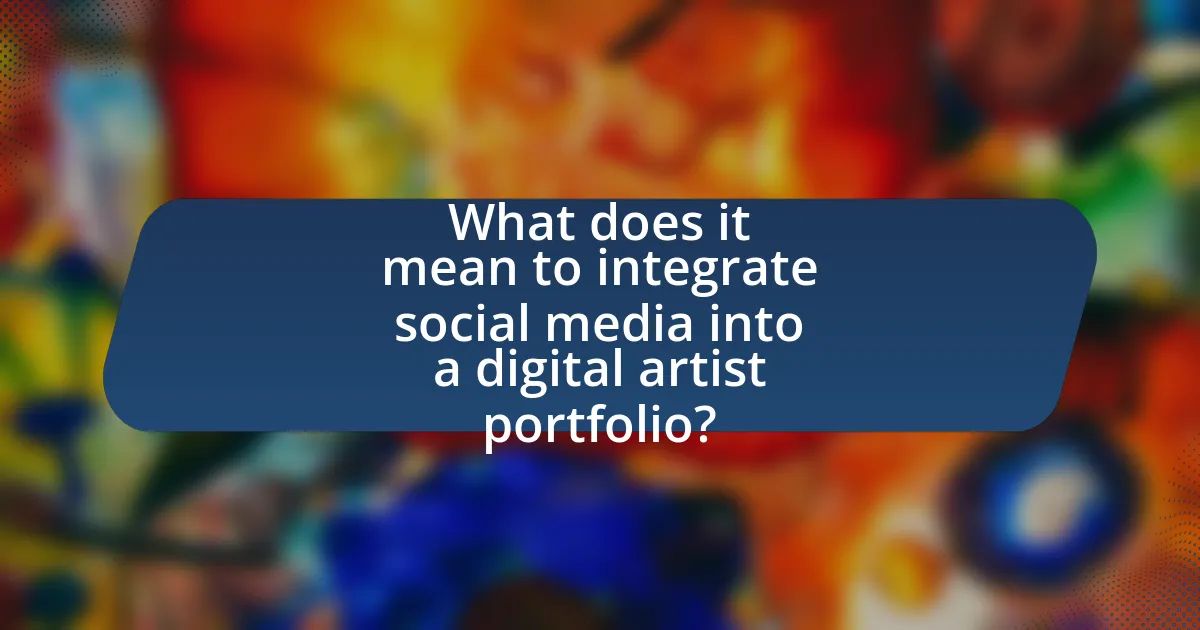
What does it mean to integrate social media into a digital artist portfolio?
Integrating social media into a digital artist portfolio means incorporating social media platforms as a means to showcase artwork, engage with audiences, and promote the artist’s brand. This integration allows artists to reach a broader audience, as social media platforms like Instagram, Facebook, and Twitter have millions of active users, providing a vast potential market for their work. By sharing their portfolio on these platforms, artists can gain visibility, receive feedback, and foster community engagement, which can lead to increased opportunities for collaboration and sales.
How can social media enhance a digital artist’s visibility?
Social media enhances a digital artist’s visibility by providing platforms for sharing artwork, engaging with audiences, and building a personal brand. These platforms, such as Instagram and Twitter, allow artists to showcase their work to a global audience, increasing the likelihood of discovery. For instance, a study by the Pew Research Center found that 72% of adults use at least one social media site, indicating a vast potential audience for artists. Additionally, social media algorithms often promote content that receives high engagement, further amplifying an artist’s reach. By consistently posting and interacting with followers, digital artists can cultivate a loyal fan base, leading to increased opportunities for commissions and collaborations.
What platforms are most effective for showcasing digital art?
The most effective platforms for showcasing digital art include Instagram, Behance, ArtStation, and DeviantArt. Instagram allows artists to reach a broad audience through visual storytelling and hashtags, with over 1 billion monthly active users, making it ideal for engagement. Behance is tailored for creative professionals, offering a portfolio-style presentation and a community of artists, which enhances visibility among peers. ArtStation focuses specifically on game, film, media, and entertainment art, providing a platform for high-quality showcases and networking opportunities. DeviantArt, one of the largest online art communities, allows for extensive interaction and feedback, fostering a supportive environment for artists. Each platform serves distinct purposes and audiences, maximizing exposure and opportunities for digital artists.
How does audience engagement on social media impact an artist’s portfolio?
Audience engagement on social media significantly enhances an artist’s portfolio by increasing visibility and attracting potential clients or collaborators. When artists actively engage with their audience through likes, comments, and shares, they create a community that fosters loyalty and interest in their work. This engagement can lead to higher follower counts, which directly correlates with increased exposure for the artist’s portfolio. According to a study by Hootsuite, 73% of marketers believe that engaging with customers on social media is crucial for building brand loyalty, which is essential for artists looking to establish a strong presence in their field. Therefore, effective audience engagement not only showcases an artist’s work but also builds a supportive network that can lead to new opportunities and growth in their career.
Why is it important for digital artists to have a social media presence?
Digital artists must have a social media presence to effectively showcase their work and connect with a broader audience. This visibility allows artists to gain recognition, attract potential clients, and build a community around their art. According to a survey by the Creative Industries Federation, 70% of artists reported that social media significantly contributed to their career development by providing platforms for networking and collaboration. Additionally, social media algorithms favor engaging content, which can lead to increased exposure and opportunities for sales or commissions.
What role does social media play in building an artist’s brand?
Social media plays a crucial role in building an artist’s brand by providing a platform for direct engagement with audiences and showcasing their work. Artists can share their creations, behind-the-scenes content, and personal stories, which fosters a deeper connection with fans. According to a survey by the Pew Research Center, 72% of adults use social media, making it an essential tool for artists to reach a broad audience. Furthermore, social media algorithms can enhance visibility, allowing artists to gain followers and increase their influence in the art community. This direct interaction and visibility contribute significantly to brand recognition and loyalty among fans.
How can social media help in networking with other artists and potential clients?
Social media facilitates networking with other artists and potential clients by providing platforms for direct interaction and visibility. Artists can showcase their work, engage with peers, and connect with clients through comments, shares, and direct messages. For instance, platforms like Instagram and LinkedIn allow artists to build a professional presence, share portfolios, and participate in industry discussions, which can lead to collaborations and job opportunities. According to a survey by the Pew Research Center, 72% of adults use social media, indicating a vast audience for artists to reach and network with.
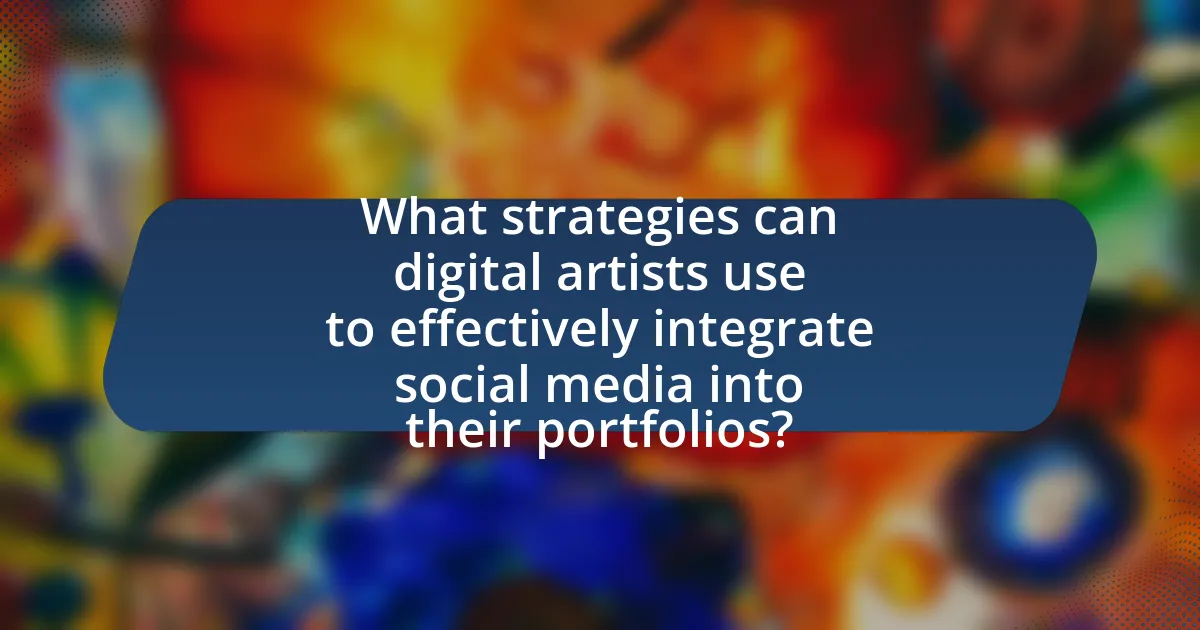
What strategies can digital artists use to effectively integrate social media into their portfolios?
Digital artists can effectively integrate social media into their portfolios by showcasing their work across multiple platforms, engaging with their audience, and utilizing analytics to refine their strategies. By consistently posting high-quality images of their artwork on platforms like Instagram, Twitter, and Pinterest, artists can reach a broader audience and attract potential clients. Engaging with followers through comments, stories, and live sessions fosters community and encourages sharing, which can lead to increased visibility. Additionally, using analytics tools available on these platforms allows artists to track engagement metrics, helping them understand what content resonates most with their audience and adjust their posting strategies accordingly. This approach not only enhances their portfolio but also builds a personal brand that can lead to more opportunities in the digital art space.
How can artists choose the right social media platforms for their work?
Artists can choose the right social media platforms for their work by assessing their target audience, the nature of their art, and the unique features of each platform. For instance, visual artists may benefit from platforms like Instagram and Pinterest, which prioritize imagery, while musicians might find platforms like SoundCloud and TikTok more effective for sharing audio content. Research indicates that 71% of consumers are more likely to purchase from a brand they follow on social media, highlighting the importance of selecting platforms that align with audience engagement and content type. By analyzing demographics and user engagement statistics, artists can strategically select platforms that enhance their visibility and connect them with potential fans and clients.
What factors should be considered when selecting platforms?
When selecting platforms for integrating social media into a digital artist portfolio, key factors include audience reach, platform features, and content compatibility. Audience reach determines the potential visibility of the artist’s work; for instance, platforms like Instagram and Pinterest have large user bases that favor visual content. Platform features, such as analytics tools and engagement options, enable artists to track performance and interact with followers effectively. Content compatibility ensures that the platform supports the type of media the artist creates, such as images, videos, or live streams, which is crucial for showcasing artistic work effectively.
How can artists tailor their content for different social media channels?
Artists can tailor their content for different social media channels by understanding the unique characteristics and audience preferences of each platform. For instance, Instagram favors visually striking images and short videos, making it ideal for showcasing artwork through high-quality photos and engaging stories. In contrast, Twitter emphasizes concise text and real-time engagement, so artists should focus on sharing updates, thoughts, and links to their work in a succinct manner. Facebook allows for longer posts and community interaction, enabling artists to share detailed narratives about their projects and connect with followers through groups. TikTok, with its focus on short, entertaining videos, encourages artists to create behind-the-scenes content or time-lapse videos of their creative process. By adapting their content style and format to fit these platform-specific norms, artists can effectively engage their target audiences and enhance their online presence.
What types of content should artists share on social media?
Artists should share a variety of content on social media, including their artwork, behind-the-scenes processes, and personal stories. Sharing artwork allows artists to showcase their skills and attract potential buyers or collaborators. Behind-the-scenes content, such as work-in-progress images or videos, engages audiences by providing insight into the creative process, fostering a deeper connection with followers. Personal stories and experiences can humanize the artist, making their work more relatable and encouraging audience interaction. According to a study by Hootsuite, posts that include personal stories receive 30% more engagement than standard promotional content, highlighting the effectiveness of diverse content types in building an artist’s online presence.
How can behind-the-scenes content enhance audience connection?
Behind-the-scenes content enhances audience connection by providing transparency and authenticity, allowing audiences to feel more involved in the creative process. This type of content fosters a sense of intimacy, as viewers gain insight into the artist’s journey, techniques, and challenges. Research indicates that 70% of consumers feel more connected to brands that share behind-the-scenes content, as it humanizes the creator and builds trust. By showcasing the effort and thought that goes into the work, artists can create a deeper emotional bond with their audience, ultimately leading to increased loyalty and engagement.
What are the benefits of sharing process videos or tutorials?
Sharing process videos or tutorials enhances audience engagement and builds trust with viewers. By providing visual insights into the creative process, artists can demystify their techniques, making their work more relatable and accessible. Research indicates that 54% of consumers prefer video content from brands they support, highlighting the effectiveness of video in capturing attention and fostering connections. Additionally, tutorials can position artists as experts in their field, increasing their credibility and attracting a larger following. This combination of engagement, relatability, and authority ultimately contributes to a stronger digital portfolio and increased opportunities for collaboration and sales.
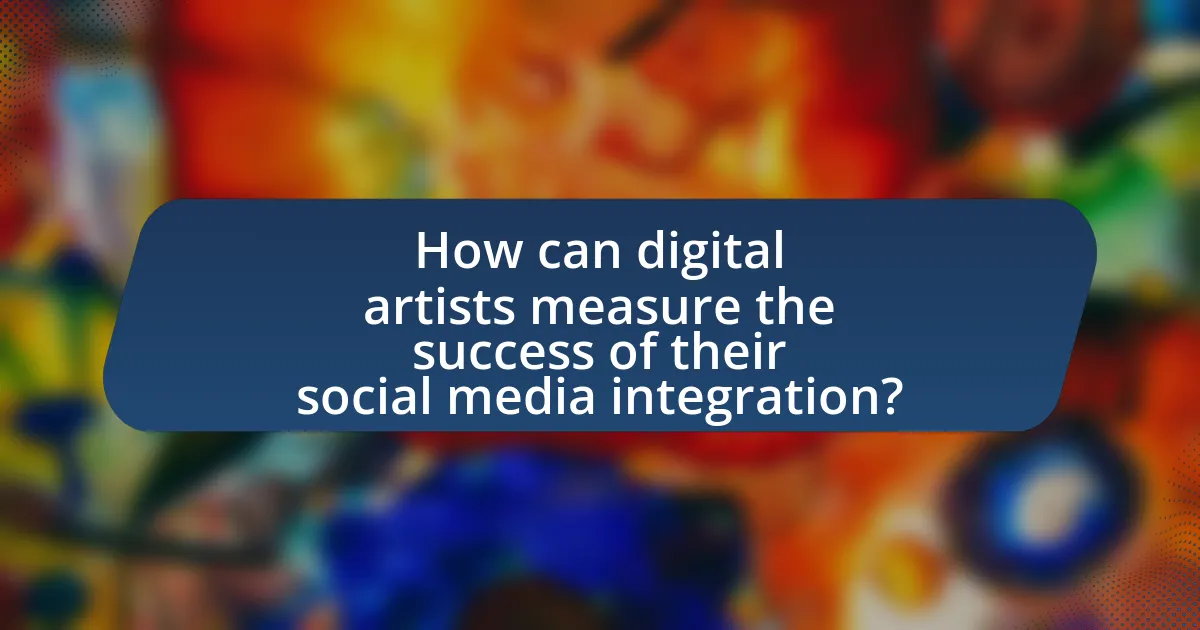
How can digital artists measure the success of their social media integration?
Digital artists can measure the success of their social media integration by analyzing engagement metrics such as likes, shares, comments, and follower growth. These metrics provide quantitative data that reflects audience interaction and interest in the artist’s work. For instance, a study by Hootsuite in 2021 indicated that posts with higher engagement rates often correlate with increased visibility and reach, demonstrating the effectiveness of social media strategies. Additionally, tracking website traffic from social media platforms using tools like Google Analytics can reveal how social media efforts drive potential clients or fans to the artist’s portfolio, further validating the success of their integration.
What metrics should artists track to evaluate their social media impact?
Artists should track engagement rate, follower growth, reach, impressions, and conversion rate to evaluate their social media impact. Engagement rate measures the level of interaction (likes, comments, shares) relative to the number of followers, indicating how well content resonates with the audience. Follower growth tracks the increase in followers over time, reflecting the artist’s expanding audience. Reach indicates the total number of unique users who see the content, while impressions measure how often the content is displayed, regardless of clicks. Conversion rate assesses how many users take a desired action, such as visiting a website or making a purchase, demonstrating the effectiveness of social media in driving tangible results. These metrics provide a comprehensive view of an artist’s social media performance and influence.
How can engagement rates inform an artist’s strategy?
Engagement rates can inform an artist’s strategy by providing insights into audience preferences and content effectiveness. High engagement rates indicate that the audience resonates with the artist’s work, allowing the artist to tailor future content to maintain or increase interest. For instance, if an artist notices that posts featuring behind-the-scenes content receive more likes and shares, they can prioritize similar content to enhance audience connection. Additionally, analyzing engagement metrics can help artists identify optimal posting times and formats, leading to more effective outreach. According to a study by Hootsuite, posts with higher engagement rates can lead to a 50% increase in overall visibility, reinforcing the importance of these metrics in shaping an artist’s strategic decisions.
What tools can assist in analyzing social media performance?
Tools that can assist in analyzing social media performance include Hootsuite, Sprout Social, and Google Analytics. Hootsuite provides comprehensive analytics on engagement, reach, and audience demographics across multiple platforms, allowing users to track performance metrics effectively. Sprout Social offers in-depth reporting features that help users understand their social media impact through engagement rates and content performance analysis. Google Analytics can track referral traffic from social media to websites, providing insights into user behavior and conversion rates. These tools are widely recognized for their effectiveness in delivering actionable insights into social media strategies.
How can artists adapt their strategies based on feedback and analytics?
Artists can adapt their strategies based on feedback and analytics by analyzing audience engagement metrics and adjusting their content accordingly. For instance, if analytics reveal that certain types of posts receive higher engagement, artists can increase the frequency of similar content to enhance visibility and connection with their audience. Additionally, direct feedback from followers, such as comments and messages, can guide artists in refining their artistic style or themes to better resonate with their audience. Research indicates that artists who actively respond to audience feedback and utilize analytics tools, such as Instagram Insights or Facebook Analytics, can increase their follower engagement by up to 30%, demonstrating the effectiveness of data-driven strategy adjustments.
What steps should be taken to refine content based on audience response?
To refine content based on audience response, analyze engagement metrics, gather feedback, and adjust content accordingly. First, track key performance indicators such as likes, shares, comments, and click-through rates to identify which content resonates most with the audience. Next, solicit direct feedback through surveys or polls to understand audience preferences and pain points. Finally, use this data to modify existing content or create new content that aligns better with audience interests, ensuring that the adjustments are informed by concrete metrics and feedback. This approach is supported by studies indicating that data-driven content strategies significantly enhance audience engagement and satisfaction.
How can artists stay updated with social media trends to remain relevant?
Artists can stay updated with social media trends by actively engaging with platforms, following industry leaders, and utilizing analytics tools. Engaging with platforms like Instagram, TikTok, and Twitter allows artists to observe trending content and audience preferences in real-time. Following industry leaders and influencers provides insights into emerging trends and best practices, as they often share valuable information and updates. Additionally, using analytics tools helps artists track their own performance and understand what resonates with their audience, enabling them to adapt their strategies accordingly. According to a 2022 report by Hootsuite, 73% of marketers believe that social media is effective for their business, highlighting the importance of staying current with trends to maintain relevance.
What are some best practices for integrating social media into a digital artist portfolio?
To effectively integrate social media into a digital artist portfolio, artists should ensure consistent branding across platforms. This includes using the same profile picture, bio, and visual style to create a cohesive identity. Additionally, artists should regularly share their work on social media, utilizing features like stories and reels to engage followers and showcase their creative process. Engaging with the audience through comments and direct messages fosters community and encourages sharing, which can increase visibility. Furthermore, artists should link their social media accounts to their portfolio website, allowing visitors to easily navigate between platforms. According to a survey by the Creative Industries Federation, 70% of artists reported that social media significantly increased their exposure and opportunities.
How can consistency in posting improve audience retention?
Consistency in posting enhances audience retention by establishing a reliable schedule that audiences can anticipate. When content is shared regularly, it fosters a sense of familiarity and trust, encouraging followers to engage more frequently. Research indicates that brands that post consistently see a 67% increase in audience engagement compared to those that do not maintain a regular posting schedule. This regularity not only keeps the audience informed but also reinforces brand identity, making it easier for followers to remember and connect with the content.
What are effective ways to encourage audience interaction and feedback?
Effective ways to encourage audience interaction and feedback include utilizing polls, asking open-ended questions, and hosting live Q&A sessions. Polls engage the audience by allowing them to express preferences or opinions, which can be easily integrated into social media platforms like Instagram and Twitter. Open-ended questions invite deeper responses and foster conversation, encouraging followers to share their thoughts and experiences related to the artist’s work. Live Q&A sessions create real-time engagement, allowing the audience to ask questions directly, which can enhance their connection to the artist and their portfolio. These methods have been shown to increase audience participation and feedback significantly, as evidenced by studies indicating that interactive content generates up to 2.5 times more engagement than static content.
